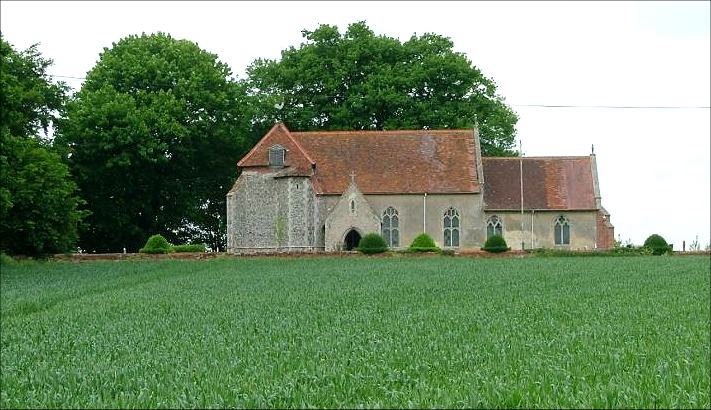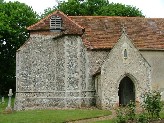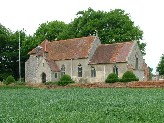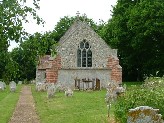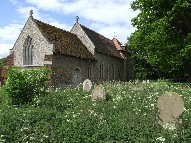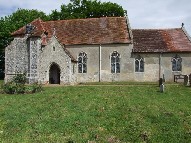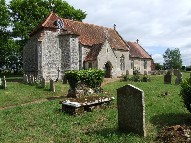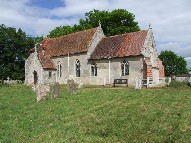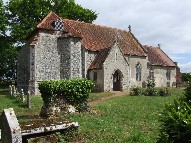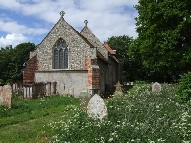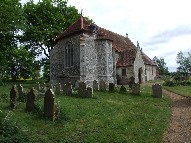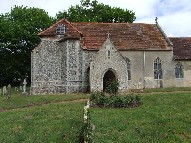| |
|
St
Leonard, Billingford
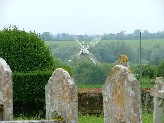 |
|
If I told
you that St Leonard is an ancient treasure house
in a beautiful hill top graveyard, that you reach
it up a narrow track, that on a day in late
spring there is bird song all about and a
windmill turning lazily in the valley below, it
would make you want to visit it. If I told you
that to get to the narrow track you would need to
negotiate one of Norfolk's most hellish roads,
the A143, with juggernauts hurtling towards the
ports and cars overtaking crazily, it would
probably make you less keen. At one time, the
church was difficult to visit for another reason:
incredibly, visitors, weren't welcome. When I
first came this way in 2005, the Scole benefice
had a reputation for not allowing keys to be
borrowed. But all that has changed. |
We headed back to
Billingford in May 2007. We'd been border-hopping,
working our way down the Waveney Valley visiting churches
in both counties. We'd found all the Suffolk ones open,
and standing in Oakley churchyard, gazing out across the
valley to Billingford windmill, the copse of trees that
enclose St Leonard's graveyard on the hill above seemed
most enticing. We headed down the hill and across the
narrow bridge, and climbed again the track to the church.
The pretty church
revealed itself from behind the trees. The tower is
capped slightly above nave level. Was it ever finished?
Simon Cotton tells me that there was a bequest in 1527
for its construction - perhaps it was only begun before
the Anglican Reformation intervened. The nave and chancel
are a pleasing combination of Dec and Perp, and those big
red roofs glowed handsomely in the sunshine that hadn't
been predicted by the forecasters.
I was optimistic,
and not just because of the sunny day. I had been told
that, now, all the churches in the Scole benefice are
either open or have keyholder notices. I think this may
be due in part to the Diocese of Norwich having appointed
an Open Churches Officer who happen to live in Scole. His
name was Ralph Barnett, and although he had now moved
onto another challenge he seemed to have made a big
difference.
| There had
also been the appointment of a new and
enthusiastic Rector to the Scole benefice. Quite
by coincidence, we met both of them outside St
Leonard; we parked on the grass verge, and found
they were parked behind us.The Rector, a bluff
Yorkshireman, answered our request for access
with the question "why, are you collecting
the silver?" to which the obvious answer was
"yes, and we only need this one for the full
set!". The freemasonry of English humour,
which must baffle any foreigner, was complete. For some reason,
this exchange was enough for Ralph to recognise
me. We'd previously had an e-mail correspondence.
It is always reassuring to meet people who are
enthusastic about the life of medieval churches,
and Ralph's zeal is infectious. I could easily
see how he had got the good people of the Waveney
Valley thinking in a new way about how their
church could provide a welcome.
|
|
 |
The great majority
of Norfolk churches are, in fact, open every day, but
those that are kept locked tend to huddle together as if
in mutual misery - the area south of Norwich, the
Thetford area, and, until recently, this place. It has to
be said that St Leonard still isn't actually open, but it
is certainly a step in the right direction to be let in
without suspicion.
We stepped into a
delightful, rural, rustic interior, quite the loveliest
of little churches. It feels smaller inside than out. The
19th century restoration seems to have been more of a
reordering than a refurbishing. The medieval font, in the
typical East Anglian design, leads to medieval bench ends
with grotesque faces on the poppyheads. An elegant 17th
century font cover is matched by a pulpit of the same age
on the other side of the range of benches.
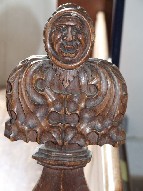 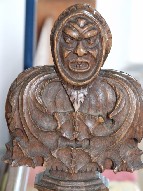 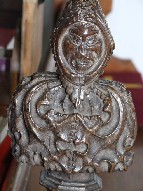
Some ancient glass
is largely heraldic, although there are fragments of
other late medieval themes set around them. A great
curiosity is the wall painting on the south wall. It
appears to show several different scenes, perhaps once
part of a larger scheme. In the clearest, several figures
stand in a doorway. Could it be one of the Works of
Mercy?
The pretty screen
is very small, just two double lights either side of the
centre, but it is imposing in this tiny space. The
corbels that hold up the roofs are old too. It is all
very pleasing; no outstanding treasures, but a harmonious
whole bringing together elements of the late Medieval and
the early Modern, crystallised sensitively by the
Victorians. It is delightful.
One of the young
men who set out from this tiny parish for the killing
fields of the First World War received the Victoria Cross
- as, indeed, did a soldier from neighbouring Scole.
Billingford's was a man called Flowerdew, a name
remembered elsewhere in the church from an earlier
generation.
| Mortlock
became quite emotional about him, recalling
Wilfred Owen's words Was it for this the clay
grew tall? O what made fatuous sunbeams toil to
break earth's sleep at all? Even more moving
than this is the framed photograph set on the
font. Six of the young men of Billingford choir
pose proudly in their uniforms before heading off
to war. Only two survived: Sam Fisher and Leonard
Bloomfield in the front row. The names of the
other four are listed on the parish war memorial.
Four out of six being killed may seem a lot, but
this was roughly par for the course for the 'Old
Contemptibles' who signed up at the very start of
the First World War.
|
|
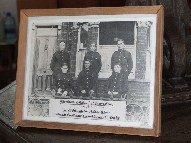 |
Simon Knott, June 2005, updated May 2007
|
|
|

